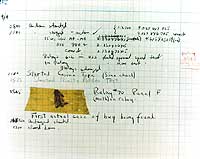|
Fx3™ is the industry's most complete debugging and excellent for C/C++ and assembly language as well. Fx3's easy-to-use graphical and command line interfaces and extensive feature set, provides superior analysis and control during the debug process on x86_64/Linux, Windows and Mac OS/Intel systems. Debug multi-threaded OpenMP Fortran programs. Compatible with compilers from Absoft, GNU, Intel and Pathscale means Fx3 is very cost effective because a single copy can work with compilers from multiple vendors. Designed by Fortran experts for Fortran. The only commercial Fortran debugger designed by Fortran experts, Fx3 is much more effective than gdb and related debuggers because Fx3 handles Fortran constructs that gdb and other debuggers do not understand. Fx3™ can handle it all efficiently in a user friendly environment. The Absoft Fx3™ Graphical Debugger is the successor to the popular Fx2 Debugger and comes bundled with all Absoft Pro Fortran products for Windows, Linux and Mac OS at no additional cost. Fx3 is also available as a stand-alone product for x86_x64 Linux systems and MacOS/Intel. More... |
 |
Stichwörter
Key Benefits | Special Features | Ease of Use
Key Benefits
|
|
Special Features
Debugger Cross-platform support for Fortran, C, C++, Assembler
- Supported Platforms:
- Linux and MacOS
- Windows - Bundled with Pro Fortran (Not Available as a Stand-Alone Debugger)
- x86 and x86-64 processors
- Dwarf1, Dwarf2, Stabs, Codeview debug formats
- Elf, Mach-O, Coff, Xcoff, PEF object file formats
- Procfs, Win32 debug APIs
- 32-bit and 64-bit platforms
- Fortran 77/90/95, C/C++ & Assembly
Standard Debugging Features
- Source and assembly level stepping
- Breakpoints:
- Conditional
- Hardware
- Command Execution
- Stack trace back
- Function evaluation
- Signal handling
Extensible Debugging Features
- Control language interpreter
- Support for multiple interfaces:
- Callbacks for integrated interface (i.e. GUI)
- Multiple command output formats
- Standard Fx format
Fortran 95/90 Debugging Support
- Modules
- Common blocks
- Allocatable pointers
- User-defined types
- Array syntax
- Expression syntax
Fortran 77 Debugging Support
- Native Fortran data types
- Adjustable arrays
- Full Fortran string support
- Expression syntax
- VAX structures and unions
- Cray pointers
C/C++ Debugging Support
- C/C++ data types
- Expressions
- Structures/classes/unions
- Access to C++ class information
More Debugging Features
- Elf object file and core file support
- Shared object support
- Process attach and detach
- Multi-process debugging
- Thread debugging using libthreaddb
- OpenMP:
- Status window for debugging OpenMP programs
x86 Features
- 64-bit symbolic disassembly
- Extended register support
- SIMD floating point registers
- Hardware breakpoints
Absoft's Fx3™ Comparison to GNU's gdb (and derivative debuggers)
- Better features:
- Full Fortran 9x,77 support
- Single code base
- Commercially supported
- Commitment to future support
Graphical capabilities
- Hover feature quickly displays values of variables
- Interactive inspectors provide fast access to functions and data
- Display local, file static, or global variables
- Type panes display fundamental types, array dimensions, enumeration constants, structure and union definitions
- Scrollable output pane displays variable values
- All output displays can be hidden and are dockable & moveable
- All output displays are user configurable
Process control
- Automatic return from procedures
- Single step machine instructions
- Single step source statements
- Step over or into procedure calls
- Restart program execution with same or different arguments
- Resume program execution with optional temporary or conditonal breakpoint
- Break at source line, procedure entry, or symbolic address
- Specify commands to be executed for each breakpoint
- Out-of-sequence procedure execution with symbolic arguments
- Monitor symbols for change in value (or conditionally against specific values)
- Stack trace shows execution chain with procedure and filename
Information Presentation
- Graphical or full screen character display interfaces
- Command and expression evaluation based on active procedure
- Program code displayed as source or machine code disassembly
- Show registers, variables, structures, procedures, breakpoints, file access
- Select symbols based on storage attributes, scope, symbol representation, recursive name location
- Display process symbols, debugger defined variables, F77 floating point intrinsics, recursive local variable specification, C operators
- Sortable arrays and array sections
Ease of Use
Fx3™ allows you to focus quickly on identifying problem areas in programs. The Fx3™ Debugger comes with a graphical user interface (GUI) with point and click ease of use. This GUI is complete with tabbed source code and assembly views, toolbars, and dock-able stack, console, symbol, register windows, source browser and memory windows. Dynamically updating windows and visual indicators help developers readily see the changing state of a program.
Automatic source code "tool tips" and color syntax also make it easy to obtain the current state of programs at a glance. Setting breakpoints and controlling program execution is also a snap. The "save" feature allows developers to easily save and restore information about a program's debug session, such as breakpoints, source paths, program arguments, console and symbol window history, active symbol window variables, and the working directory.
The symbols window is easily navigated with either a mouse or keyboard accelerators. The graphical user interface can be customized for each individual's work flow. Source browser allows easy navigation of program source files and functions.
Advanced Fx3™ users can enter any command line debugger commands via the console window, or configure the debugger interface to their individual taste via the preference dialog, and dock-able windows and toolbars.
Fx3™ tracks the current state of your program and provides dynamic feedback by automatically tracking and updating the current stack frame, instruction pointer, local, static, and global variables, the current register state and program status. View windows can be docked, floating or closed allowing the debugger to be configured for a developer's typical workflow.
Key interface features
Source Code View
- Visual source stepping indicator
- Point and click breakpoint and code execution control
- Search text and goto line functionality
- Automatic tool tips displays current program variable state at a glance
- Color syntax makes your Fortran and C/C++ code easier to read and navigate
Assembly View
- Visual stepping indicators
- View mixed source and assembly at once
- Point and click breakpoint and code execution control
- Search text and goto address functionality
- Dynamically updates assembly for current stack frame
Symbols View
- Enter any variable or expression for evaluation by debugger Fortran or C/C++ expression analyzers
- Dynamically displays program state for any local, static, or global variables
- Easily keep track of vital variables and expressions by adding them to a User "scratch" view.
- Can be customized to display symbol types
- Allows user to either keep a static snapshot of program state or to dynamically update values
- Navigate easily using the mouse or keyboard
- Edit values inline by double-clicking values or pressing tab key on selected variable
- Expand and collapse complex variables
- Optional array dialog can be used to display the values of a range of array elements
Stack View
- Automatically track current stack frame.
- Easily navigate up and down the program's stack frames.
Register View
- Dynamically display the contents of the general registers, floating point registers, or vector registers
Source Browser
- Pull-down menus allow easy navigation of program source files and functions
- And much more…
Texte großenteils © 1996-2012 ABSOFT Corporation
 Fx3™ Graphical Debugger
Fx3™ Graphical Debugger